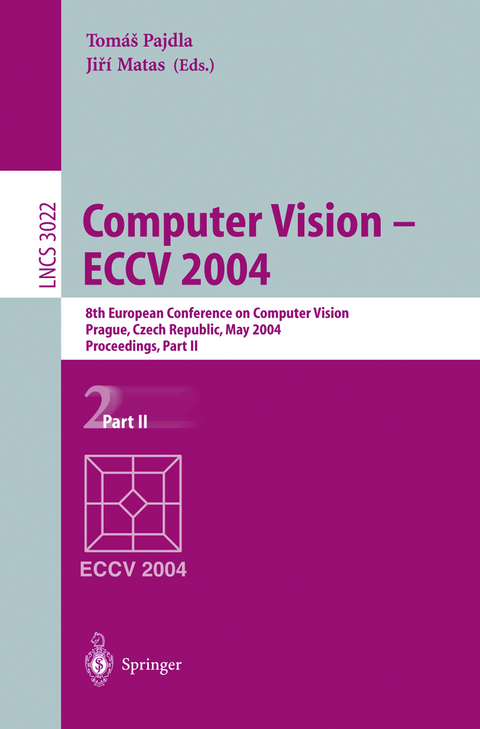
Computer Vision - ECCV 2004
Springer Berlin (Verlag)
978-3-540-21983-5 (ISBN)
Geometry.- A Generic Concept for Camera Calibration.- General Linear Cameras.- A Framework for Pencil-of-Points Structure-from-Motion.- What Do Four Points in Two Calibrated Images Tell Us about the Epipoles?.- Feature-Based Object Detection and Recognition II.- Dynamic Visual Search Using Inner-Scene Similarity: Algorithms and Inherent Limitations.- Weak Hypotheses and Boosting for Generic Object Detection and Recognition.- Object Level Grouping for Video Shots.- Posters II.- Statistical Symmetric Shape from Shading for 3D Structure Recovery of Faces.- Region-Based Segmentation on Evolving Surfaces with Application to 3D Reconstruction of Shape and Piecewise Constant Radiance.- Human Upper Body Pose Estimation in Static Images.- Automated Optic Disc Localization and Contour Detection Using Ellipse Fitting and Wavelet Transform.- View-Invariant Recognition Using Corresponding Object Fragments.- Variational Pairing of Image Segmentation and Blind Restoration.- Towards Intelligent Mission Profiles of Micro Air Vehicles: Multiscale Viterbi Classification.- Stitching and Reconstruction of Linear-Pushbroom Panoramic Images for Planar Scenes.- Audio-Video Integration for Background Modelling.- A Combined PDE and Texture Synthesis Approach to Inpainting.- Face Recognition from Facial Surface Metric.- Image and Video Segmentation by Anisotropic Kernel Mean Shift.- Colour Texture Segmentation by Region-Boundary Cooperation.- Spectral Solution of Large-Scale Extrinsic Camera Calibration as a Graph Embedding Problem.- Estimating Intrinsic Images from Image Sequences with Biased Illumination.- Structure and Motion from Images of Smooth Textureless Objects.- Automatic Non-rigid 3D Modeling from Video.- From a 2D Shape to a String Structure Using the Symmetry Set.- Extrinsic Camera Parameter Recovery from Multiple Image Sequences Captured by an Omni-Directional Multi-camera System.- Evaluation of Robust Fitting Based Detection.- Local Orientation Smoothness Prior for Vascular Segmentation of Angiography.- Weighted Minimal Hypersurfaces and Their Applications in Computer Vision.- Interpolating Novel Views from Image Sequences by Probabilistic Depth Carving.- Sparse Finite Elements for Geodesic Contours with Level-Sets.- Hierarchical Implicit Surface Joint Limits to Constrain Video-Based Motion Capture.- Separating Specular, Diffuse, and Subsurface Scattering Reflectances from Photometric Images.- Temporal Factorization vs. Spatial Factorization.- Tracking Aspects of the Foreground against the Background.- Example-Based Stereo with General BRDFs.- Adaptive Probabilistic Visual Tracking with Incremental Subspace Update.- On Refractive Optical Flow.- Matching Tensors for Automatic Correspondence and Registration.- A Biologically Motivated and Computationally Tractable Model of Low and Mid-Level Vision Tasks.- Appearance Based Qualitative Image Description for Object Class Recognition.- Consistency Conditions on the Medial Axis.- Normalized Cross-Correlation for Spherical Images.- Bias in the Localization of Curved Edges.- Texture.- Texture Boundary Detection for Real-Time Tracking.- A TV Flow Based Local Scale Measure for Texture Discrimination.- Spatially Homogeneous Dynamic Textures.- Synthesizing Dynamic Texture with Closed-Loop Linear Dynamic System.
| Erscheint lt. Verlag | 28.4.2004 |
|---|---|
| Reihe/Serie | Lecture Notes in Computer Science |
| Zusatzinfo | XXVIII, 624 p. |
| Verlagsort | Berlin |
| Sprache | englisch |
| Maße | 155 x 235 mm |
| Gewicht | 700 g |
| Themenwelt | Informatik ► Grafik / Design ► Digitale Bildverarbeitung |
| Mathematik / Informatik ► Informatik ► Software Entwicklung | |
| Informatik ► Theorie / Studium ► Künstliche Intelligenz / Robotik | |
| Schlagworte | 3D • 3D Reconstruction • Bildbearbeitung • camera calibration • classification • Classifier SYstems • Computational Geometry • computer vision • Computervision • Geometric Computation • Image Processing • Image Segmentation • learning • motion tracking • Mustererkennung • Object recognition • Shading • shape reconstruction • Stereo • Stereo Vision • Textur • Vision Algorithms • vision systems |
| ISBN-10 | 3-540-21983-8 / 3540219838 |
| ISBN-13 | 978-3-540-21983-5 / 9783540219835 |
| Zustand | Neuware |
| Informationen gemäß Produktsicherheitsverordnung (GPSR) | |
| Haben Sie eine Frage zum Produkt? |
aus dem Bereich


